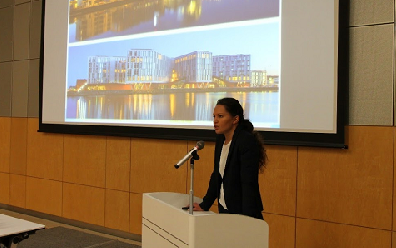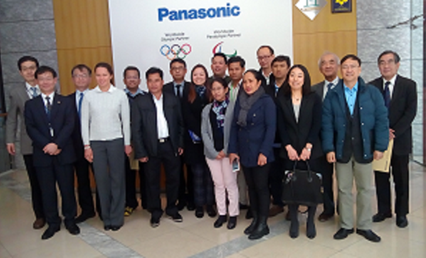
2. SUMMARIES OF REMARKS, PRESENTATIONS, AND SITE VISIT
※Please click on the text to see the presentation materials.
Opening Remark
Mr. Jiro Sogawa, Managing Director, ECCJ made an opening remark. He talked about the back ground of the workshop, the relations with the last SE4ALL Tokyo Forum and ECCJ’s long years of ASEAN-Japan cooperation on EE&C including ECAP series. He also mentioned that objectives of the workshop were to discuss detailed energy efficiency measures at design, construction, operation, etc. of buildings. He had concluded his remark with expressed appreciation for METI, ACE, guest speakers, participants, and other related parties who contributed to the realization of the workshop and wishing the success of the workshop.
Keynote Lecture

Keynote lecture by Dr. Ksenia Petrichenko from C2E2
Dr. Ksenia Petrichenko, Researcher, Copenhagen Centre on Energy Efficiency (C2E2) delivered her lecture on “Accelerating Energy Efficiency, especially in Buildings”. The comprehensive presentation introduced “Global Energy Efficiency Accelerator Platform” as an excellent vehicle for promoting energy efficiency by providing practical advice to countries and cities on implementation of energy efficiency measures and also access to the best practices and promising partners in key energy users. C2E2 is functioning as a secretariat of the platform. She stressed the following three messages on building codes: (1) importance of actual energy use, (2) high level of ambition and (3) engagement of different levels of governance (such as country, city and district).
Lectures by Japanese Experts
Dr. Masato Miyata, Senior Researcher, National Institute for Land and Infrastructure Management (NILIM), Ministry of Land, Infrastructure, Transport and Tourism (MLITT) gave his lecture on “Features and Characteristics of New Building Energy Standards of Japan”. He reviewed the history, the status and future plans on JBEC. JBEC was revised in 2013, and newly planned “specified buildings (large non-residential buildings legally specified)” was going to be required to comply with the building energy efficiency standards from April 2017. He also explained how to evaluate the key index on Building Energy Efficiency (BEE) such as Primary Energy Consumption. He mentioned that the on-line calculation systems developed by NILIM and BRI (Building Research Institute) was available to obtain such figures.
Ms. Yuko Nishida, Senior Staff, Bureau of Environment, Tokyo Metropolitan Government delivered her lecture on “City-led Building Energy Efficiency, Tokyo and Other Cities”. She introduced activities of mega cities concerning BEE, emphasizing the city’s special role in the phase of operation, including guidance on energy audits and retro-fitting of existing buildings. She mentioned that there were recently much more city-led BEE initiatives in the world – USA, Europe, Asia, etc. In the case of Tokyo, the BEE policy framework features were controlling not only over new buildings but also over existing ones – such as Cap & Trade Program and Carbon Reduction Reporting for Small Medium-size Enterprise (SME). Her past experiences of working in the field showed that international cooperation among cities was very effective to further promote BEE.
Mr. Ryozo Sato, Senior General Manager, EC Solution Dept., ECCJ gave his lecture on “Energy Conservation (EC) Guidelines for Buildings of the EC Act – Current State and Issues of the Benchmark“. His presentation covered extensive issues, such as BEE issue in the Japanese EC Act and related legal framework, the benchmark system in Japan, the benchmark system exclusively for the building sector, etc. His ending comments were full of suggestions on how ASEAN countries could utilize the Japanese experiences to promote BEE more effectively and overcoming gaps in situations in respective countries.
Mr. Yasushi Tanaka, Senior General Manager, International Collaboration Center, ECCJ delivered his lecture on “Best Practices of Energy Conservation in Buildings by way of Energy Management”. He introduced two Best Practices: (1) Tokyo Square Garden and (2) Mie University. The former is a commercial building which fully utilized versatile advanced EE&C technologies, including visualization of energy consumption, and adopted useful methods for the tenants, such as a tenant ranking system in EE&C and pay-as-you-go billing system for air conditioning. The latter is an university building, under strong President’s leadership, which put into practice a new Energy Management System consisting of energy creation, saving and storage. The both cases attained remarkable results in EE&C and were awarded in Japan.
Site Visit (Panasonic Shiodome Building)
A half-day tour to Panasonic Shiodome Building was arranged for the participants. Panasonic is famous for its company policy of putting importance on environmental issues. The Shiodome Building, as a whole, serves as a showcase of the company’s new business initiatives.
The key words were (1) intelligent energy management (airflow systems, greening of rooftop gardens, photovoltaic power generation systems, and area control systems), (2) next-generation lighting (LED lighting, new light illumination technique, and architectural lighting) and (3) evolving network (building energy management system, or BEMS, eco-tuning for energy efficiency, and comprehensive security systems).
The building started an initiative “Challenge 50 Project” with a target to reduce 50% of the energy consumption of the baseline figure of 2003 toward 2018 (year of the 100th anniversary of the company’s foundation). When the Great East Japan Earthquake occurred in 2011, the Japanese Government regulated power consumption in many ways. The company accelerated its efforts to reduce power consumption in answer to the government’s request, and attained its goal in 2013 (50.3% reduction), well in advance of the original target year. The name of the initiative was changed to “Sustainable 50 Project” and the efforts are still continued.

Group photo at Panasonic Shiodome Building

Appreciation speech by a representative of ASEAN participants for Panasonic
Country Report
Participants presented Country Reports which was prepared in advance for the workshop on the status and potential issues of BEC in each country, which included the following topics:
– current status and future plan,
– barriers,
– countermeasures, and
– request for support from ECCJ and SEforALL
Cambodia
Mr. Gnan Bora, Deputy Chief Officer, Ministry of Mines & Energy (MIME) explained in his Country Report presentation that there were three priority areas in National Energy Efficiency Policy and Strategy, namely industry, buildings and transportation. There were many barriers in the way ahead, but he believed various activities would effectively work together to improve the situation, such as BEC, standard & labelling for equipment, and capacity building, which were shown in the proposed future plan for Cambodia. He requested that ECCJ and SEforALL would help Cambodia carry out these activities.
Indonesia
Mr. Kunaefi, Assistant Deputy Director for Energy Efficiency Labelling Supervision, Ministry of Energy and Mineral Resources, presented in his Country Report that the status of the country’s BEC was rather advanced – existing of BEC (though mandatory only in two cities: Jakarta and Bandung), energy efficiency guidelines, regulations on building envelope, air conditioning system, lighting system, and so on. Items of barriers mentioned in the Country Report were financial incentives, shortage of energy managers and energy auditors, lack of information on energy efficiency technology, lack of activities for monitoring and verification, etc.
Lao PDR
Mr. Seumkham Thoummavongsa, Deputy Director General, Ministry of Energy and Mines (MEM), explained the present status of energy efficiency of buildings in the country. The National EE&C Policy was completed, and draft of Decree on EE&C was finalized, but drafting of Building Code was not finalized yet. Barriers were insufficient regulations of national EE&C standards and building codes, poor public awareness on EE&C issues and building codes, lack of information on available EE&C technologies, insufficient financial incentives, etc.
Malaysia
Mr. Hamizan Bin Husain, Principal Assistant Secretary, Ministry of Energy, Green Technology and Water (KeTTHA) explained that EE&C laws and regulations were already implemented in Malaysia, including Uniform Building By-Laws (UBBL) and Malaysian Standard (MS) 1525 “Energy efficiency and use of renewable energy for non-residential buildings – Code of practice”. Actually the major part of authority was kept by States, rather than Country (Federal), and so execution of regulations was depending largely on the intention of States. For example, only two States – Selangor and Terengganu – adopted the 2012 amendment of Federal UBBL containing MS 1525.
Myanmar
Ms. Aye Kay Khaing Soe, Deputy Director, Energy Efficiency & Conservation Division, Ministry of Industry, in the Country Report, described the status of developed EE&C policy/strategy, drafted EE&C Law, Minimum Energy Performance Standard (MEPS), provisional Myanmar National Building Code (MNBC), etc. The country was in the process of drafting laws and regulations by full use of committees of related parties. MNBC covered extensive issues on buildings, including energy efficiency matters, however it covers mainly safety issues and only includes very slight portion of Energy Efficiency related matters, therefore it is needed for them to extend MNBC that will duly cover energy efficiency matters.
Firstly, it is planned that the country develop Energy Efficiency Guideline for Building and related activities. Therefore, it is requested that ECCJ and SE4ALL give technical support to them in implementing Energy Efficiency related activities.
Philippines
Ms. Joan Chavez Escalona, Science Research Specialist II, Department of Energy, clarified Philippine Green Building Code (PGBC) launched in January 2016, which contained energy efficiency issues. The code embraced “Guidelines on Energy Conserving Design of Buildings” to make guidance for such issues as lighting system. The country also had publications like a booklet called “Energy Efficiency Measures in Building”. She illustrated, as an example of barriers, that only few officials of big buildings had submitted quarterly reports on their energy consumption. The submission was not mandatory, and the government might have to think of some awareness-raising or motivational measures
Singapore
Mr. Toh Eng Shyan, Director, Green Mark Department (Existing Buildings), Building and Construction Authority (BCA), presented on Singapore’s Green Building Masterplans and its green building energy efficiency standards. Key provisions to tackle the BEE issue include the public sector taking the lead in environmental sustainability, minimum green building standards for both new and existing buildings, periodic energy audit of the cooling system, and annual energy data submission. He commented that the building cooling system is one very important system of buildings in the tropics as it consumes about 30-50% of total building consumption. Thus, stringent measurement and verification requirements and continuous monitoring of the chiller plant efficiency, as well as air distribution system efficiency, are critical. He also shared on key measures in developing market solutions to help industry in EE retrofits, like the Zero Capital Partnership Scheme and standard Energy Performance Contract.
Thailand
Mr. Prakob Eamsaard, Senior Mechanical Engineer, Department of Alternative Energy Development and Efficiency (DEDE), Ministry of Energy, in his Country Report, explained the achievement of BEC in Thailand, referring to existing BEC, BEC standard for buildings, energy saving target for the future, and so on. He illustrated two items of barriers: (1) no connection between the ministerial regulation of DEDE and Building Control Law of Department of Public Works and Town & Country Planning (DPT) of Ministry of Interior, and (2) lacking of cooperation with the private sector. The former barrier would be solved by establishing DEDE/DPT subcommittee to draft the New BEC-Ministerial 2017.
